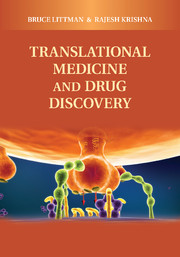Book contents
- Frontmatter
- Contents
- Contributors
- Preface
- Translational Medicine and Drug Discovery
- SECTION I TRANSLATIONAL MEDICINE: HISTORY, PRINCIPLES, AND APPLICATION IN DRUG DEVELOPMENT
- 1 TRANSLATIONAL MEDICINE: DEFINITION, HISTORY, AND STRATEGIES
- 2 TRANSLATIONAL MEDICINE AND ITS IMPACT ON DIABETES DRUG DEVELOPMENT
- 3 CHALLENGES IN ATHEROSCLEROSIS
- 4 OBESITY: NEW MECHANISMS AND TRANSLATIONAL PARADIGMS
- 5 BONE DISORDERS: TRANSLATIONAL MEDICINE CASE STUDIES
- 6 CASE STUDIES IN NEUROSCIENCE: UNIQUE CHALLENGES AND EXAMPLES
- 7 TRANSLATIONAL MEDICINE IN ONCOLOGY
- SECTION II BIOMARKERS AND PUBLIC–PRIVATE PARTNERSHIPS
- SECTION III FUTURE DIRECTIONS
- Index
- References
4 - OBESITY: NEW MECHANISMS AND TRANSLATIONAL PARADIGMS
Published online by Cambridge University Press: 04 April 2011
- Frontmatter
- Contents
- Contributors
- Preface
- Translational Medicine and Drug Discovery
- SECTION I TRANSLATIONAL MEDICINE: HISTORY, PRINCIPLES, AND APPLICATION IN DRUG DEVELOPMENT
- 1 TRANSLATIONAL MEDICINE: DEFINITION, HISTORY, AND STRATEGIES
- 2 TRANSLATIONAL MEDICINE AND ITS IMPACT ON DIABETES DRUG DEVELOPMENT
- 3 CHALLENGES IN ATHEROSCLEROSIS
- 4 OBESITY: NEW MECHANISMS AND TRANSLATIONAL PARADIGMS
- 5 BONE DISORDERS: TRANSLATIONAL MEDICINE CASE STUDIES
- 6 CASE STUDIES IN NEUROSCIENCE: UNIQUE CHALLENGES AND EXAMPLES
- 7 TRANSLATIONAL MEDICINE IN ONCOLOGY
- SECTION II BIOMARKERS AND PUBLIC–PRIVATE PARTNERSHIPS
- SECTION III FUTURE DIRECTIONS
- Index
- References
Summary
Introduction
Medical Need and History of Failure
From 1985 through 2005, the prevalence of obesity doubled in the United States. In 2005, only four states had obesity prevalence rates less than 20%, whereas 17 states had prevalence rates of at least 25%, with several exceeding 30% (Centers for Disease Control and Prevention's [CDC's] Behavioral Risk Factor Surveillance System [BRFSS]). Obesity is a growing health epidemic outside the United States as well. Conditions of overweight and obesity are the sixth most important risk factor contributing to the overall global disease burden. According to the International Obesity Task Force and the World Health Organization (WHO), globally more than 1.7 billion adults are overweight, including more than 312 million who are obese. The disease burden of excess adiposity contributes to increased risk of additional diseases, including hypertension, type 2 diabetes, atherosclerosis, osteoarthritis, and some cancers.
Lifestyle interventions are the first-line treatments for obesity, yet this precipitous increase in the prevalence of obesity has occurred despite many years of lifestyle intervention as the primary mode of therapy. The underlying reason may be that survival is dependent on avoiding a negative energy balance, and both eating and activity behaviors required to maintain a neutral or positive energy balance are regulated by hundreds of genes in scores of biochemical and neural pathways. The active regulation of energy balance of both energy intake and energy expenditure is extremely precise with the average adult maintaining energy balance to within 0.3% over several decades.
- Type
- Chapter
- Information
- Translational Medicine and Drug Discovery , pp. 89 - 114Publisher: Cambridge University PressPrint publication year: 2011



